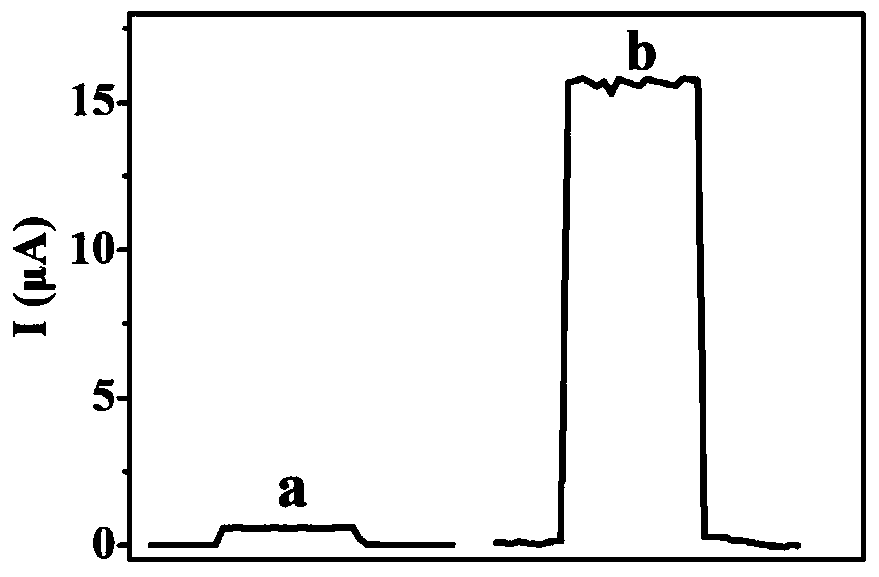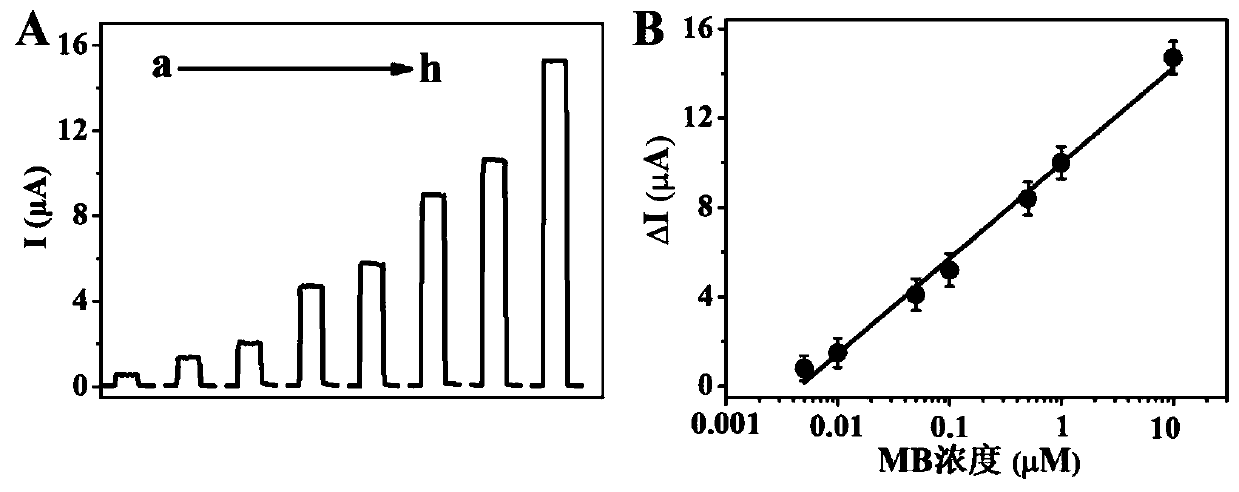Method for photoelectrochemically detecting aflatoxin based on homogeneous anode of bismuth tungstate
A kind of aflatoxin, photoelectrochemical technology, applied in the field of analysis and detection, analysis and detection technology, can solve the problems of complicated operation steps, decreased recognition efficiency, low sensitivity, etc., and achieve the effect of high sensitivity, simple operation and low cost
- Summary
- Abstract
- Description
- Claims
- Application Information
AI Technical Summary
Problems solved by technology
Method used
Image
Examples
Embodiment 1
[0027] a. Bi 2 WO 6 Preparation: Weigh 0.3g of bismuth nitrate pentahydrate and dissolve it in 20mL of dilute nitric acid with pH=1, stir magnetically until dissolved, and count it as solution A; weigh 0.17g of sodium tungstate dihydrate and dissolve it in 20mL of deionized water, Stir magnetically until dissolved, and count as solution B; add solution B dropwise to solution A, stir for 20 minutes, transfer to a 50mL autoclave, and heat at 180°C for 12 hours; after natural cooling to room temperature, anhydrous ethanol and distilled water alternately Wash and dry overnight at 60°C in a vacuum oven;
[0028] b. Preparation of Bi 2 WO 6 / ITO electrode: Weigh the pre-prepared Bi2 WO 6 The powder was added to deionized water, and ultrasonically obtained a suspension with a concentration of 1 mg / mL; drop-coated 30 μL of Bi on the surface of the pre-cleaned ITO electrode 2 WO 6 The suspension was dried at 40°C for 2 hours for later use;
[0029] c. Biorecognition and signal a...
Embodiment 2
[0032] a. Bi 2 WO 6 Preparation: Weigh 0.3g of bismuth nitrate pentahydrate and dissolve it in 20mL of dilute nitric acid with pH=1, stir magnetically until dissolved, and count it as solution A; weigh 1.49g of ammonium tungstate and dissolve it in 20mL of deionized water, stir magnetically Until it dissolves, it is counted as solution B; add solution B dropwise to solution A, stir for 20 minutes, transfer to a 50mL autoclave, and heat at 160°C for 16 hours; after naturally cooling to room temperature, wash with absolute ethanol and distilled water alternately Dry overnight at 40°C in a vacuum oven;
[0033] b. Preparation of Bi 2 WO 6 / ITO electrode: Weigh the pre-prepared Bi 2 WO 6 The powder was added to deionized water, and ultrasonically obtained a suspension with a concentration of 1 mg / mL; drop-coated 30 μL of Bi on the surface of the pre-cleaned ITO electrode 2 WO 6 The suspension was dried at 40°C for 2 hours for later use;
[0034] c. Biorecognition and signa...
PUM
 Login to View More
Login to View More Abstract
Description
Claims
Application Information
 Login to View More
Login to View More - R&D
- Intellectual Property
- Life Sciences
- Materials
- Tech Scout
- Unparalleled Data Quality
- Higher Quality Content
- 60% Fewer Hallucinations
Browse by: Latest US Patents, China's latest patents, Technical Efficacy Thesaurus, Application Domain, Technology Topic, Popular Technical Reports.
© 2025 PatSnap. All rights reserved.Legal|Privacy policy|Modern Slavery Act Transparency Statement|Sitemap|About US| Contact US: help@patsnap.com



